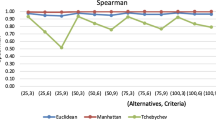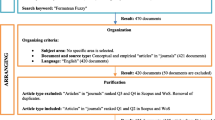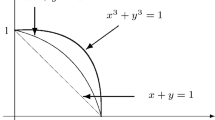Abstract
We study the relationship between the Ferrers property and the notion of interval order in the context of valued relations. Given a crisp preference structure without incomparability, the strict preference relation satisfies the Ferrers property if and only if the associated weak preference relation does. These conditions characterize a total interval order. For valued relations the Ferrers property can be written in two different and non-equivalent ways. In this work, we compare these properties by finding the kind of completeness they imply. Moreover, we study whether they still characterize a valued total interval orders.
Similar content being viewed by others
References
Bilgiç T (1998) Interval-valued preference structures. Eur J Oper Res 105:162–183
De Baets B, Fodor J (1997) Twenty years of fuzzy preference structures (1978–1997). JORBEL 37:61–82
De Baets B, Fodor J (2003) Additive fuzzy preference structures: the next generation. In: De Baets B, Fodor J (eds) Principles of fuzzy preference modelling and decision making. Academia Press, Prague, pp 15–25
De Baets B, Van de Walle B (1996) Weak and strong fuzzy interval orders. Fuzzy Sets Syst 79:213–225
De Baets B, Van de Walle B, Kerre E (1995) Fuzzy preference structures without incomparability. Fuzzy Sets Syst 76:333–348
Díaz S, De Baets B, Montes S (2007a) Additive decomposition of fuzzy pre-orders. Fuzzy Sets Syst 158:830–842
Díaz S, Montes S, De Baets B (2007b) Transitivity bounds in additive fuzzy preference structures. IEEE Trans Fuzzy Syst 15(2):275–286
Doignon J-P, Mitas J (2000) Dimension of valued relations. Eur J Oper Res 125:571–587
Doignon J-P, Ducamp A, Falmagne J-C (1984) On realizable biorders and the biorder dimension of a relation. J Math Psychol 28:73–109
Doignon J-P, Montjardet B, Roubens M, Vincke Ph (1986) Biorder families, valued relations, and preference modelling. J Math Psychol 30:435–480
Ducamp A, Falmagne J-C (1969) Composite measurement. J Math Psychol 6:359–390
Fernández E, Navarro J, Duarte A (2008) Multicriteria sorting using a valued preference closeness relation. Eur J Oper Res 185:673–686
Fernández E, Navarro J, Bernal S (2009) Multicriteria sorting using a valued indifference relation under a preference disaggregation paradigm. Eur J Oper Res 198(2):602–609
Fernandez E, Bernal S, Navarro J, Olmedo R An outranking-based fuzzy logic model for collaborative group preferences. TOP, in press. doi:10.1007/s11750-008-0072-1
Fishburn PC (1973) Binary choice probabilities: On the varieties of stochastic transitivity. J Math Psychol 10:327–352
Fodor J (1992) Traces of binary fuzzy relations. Fuzzy Sets Syst 50:331–341
Fodor J (1995) Contrapositive symmetry of fuzzy implications. Fuzzy Sets Syst 69:141–156
Fodor J, Roubens M (1994) Fuzzy preference modelling and multicriteria decision support. Kluwer Academic, Dordrecht
Fodor J, Roubens M (1995) Structure of transitive valued binary relations. Math Soc Sci 30:71–94
Gupta P, Mehlawat MK (2007) An algorithm for a fuzzy transportation problem to select a new type of coal for a steel manufacturing unit. TOP 15:114–137
Herrero C, Martínez R (2008) Up methods in the allocation of indivisibilities when preferences are single-peaked. TOP 16(2):272–283
Jenei S (2000) New family of triangular norms via contrapositive symmetrization of residuated implications. Fuzzy Sets Syst 110:157–174
Klement EP, Mesiar R, Pap E (2000) Triangular norms. Kluwer Academic, Dordrecht
Loomes G, Starmer C, Sudgen R (1991) Observing violations of transitivity by experimental methods. Econometrica 59(2):425–439
Maes KC, De Baets B (2007) On the structure of left-continuous t-norms that have a continuous contour line. Fuzzy Sets Syst 158:843–860
Maes KC, De Baets B (2009) Rotation-invariant t-norms: the rotation invariance property revisited. Fuzzy Sets Syst 160:44–51
Menger K (1951) Probabilistic theories of relations. Proc Natl Acad Sci (Math) 37:178–180
Monjardet B (1978) Axiomatiques et propriétés des quasi-ordres. Math Sci Hum 63:51–82
Montero J, Pearman AD, Tejada J (1995) Fuzzy multicriteria decision support for budget allocation in the transport sector. TOP 3:47–68
Ovchinnikov S (1991) Similarity relations, fuzzy partitions, and fuzzy orderings. Fuzzy Sets Syst 40:107–126
Roberts FS (1976) Discrete mathematical models. Prentice-Hall, New York
Roubens M, Vincke Ph (1985) Preference modelling. In: Lecture notes in economics and mathematical systems, vol 250. Springer, Berlin
Roy B (1985) Méthodologie multicritère d’aide à la décision. Economica, Paris
Roy B, Vincke Ph (1987) Pseudo-orders: definition, properties and numerical representation. Math Soc Sci 14:263–274
Tijs S, Brânzei R (2004) Various characterizations of convex fuzzy games. TOP 12:399–408
Tversky A (1969) Intransitivity of preference. Psychol Rev 76(1):31–48
Van De Walle B, De Baets B, Kerre E (1998) Characterizable fuzzy preference structures. Ann Oper Res 80:105–136
Wang T-C, Chang T-H (2007) Application of consistent fuzzy preference relations in predicting the success of knowledge management implementation. Eur J Oper Res 182:1313–1329
Zadeh L (1965) Fuzzy sets. Inf Control 8:338–353
Author information
Authors and Affiliations
Corresponding author
Rights and permissions
About this article
Cite this article
Díaz, S., De Baets, B. & Montes, S. On the Ferrers property of valued interval orders. TOP 19, 421–447 (2011). https://doi.org/10.1007/s11750-010-0134-z
Received:
Accepted:
Published:
Issue Date:
DOI: https://doi.org/10.1007/s11750-010-0134-z




